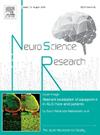二甲双胍通过诱导线粒体自噬减轻听觉细胞衰老。
IF 2.4
4区 医学
Q3 NEUROSCIENCES
引用次数: 0
摘要
年龄相关性听力损失是老年人中最常见的听力损失类型。然而,其潜在的细胞机制尚不清楚。线粒体功能受损是各种年龄相关病理的标志。为了维持衰老细胞的线粒体功能,线粒体自噬是线粒体功能失调的关键过程。二甲双胍有诱导线粒体自噬的报道。本研究旨在探讨二甲双胍对听觉细胞衰老的预防作用。低剂量H2O2代表了House Ear Institute-Organ of Corti 1 (HEI-OC1)细胞和耳蜗外体中衰老相关分泌表型(SASP)和线粒体自噬相关分子的减少。二甲双胍显著降低h2o2诱导的衰老细胞中SASP的表达。二甲双胍还降低了衰老相关的p53和p21的表达,增加了h2o2诱导的衰老细胞和耳蜗外体中与线粒体自噬相关的PINK1、Parkin和BNIP3的表达。在h2o2诱导的衰老细胞中,线粒体自噬染料和溶酶染料的共定位减少,但二甲双胍预处理显著增加了它们的共定位。二甲双胍显著降低β-半乳糖苷酶染色的衰老细胞百分比,增加h2o2诱导的衰老细胞和耳蜗外植体中OXPHOS复合物的表达。二甲双胍还显著增加了衰老细胞的线粒体功能。这些结果表明,二甲双胍通过抵消减少的线粒体自噬来防止听觉细胞过早衰老。因此,使用二甲双胍维持线粒体功能可能是预防年龄相关性听力损失的潜在策略。本文章由计算机程序翻译,如有差异,请以英文原文为准。
Metformin alleviates auditory cell senescence by mitophagy induction
Age-related hearing loss is the most common type of hearing loss in older adults. However, its underlying cellular mechanism is still unclear. Impaired mitochondrial function is a hallmark of various age-related pathologies. To maintain mitochondrial function in senescent cells, mitophagy is a crucial process for dysfunctional mitochondria turnover. Metformin has been reported to induce mitophagy. This study aimed to investigate the effect of metformin on preventing senescence in auditory cells. Low-dose H2O2 represented senescence-associated secretory phenotype (SASP) and reduced mitophagy-related molecules in House Ear Institute-Organ of Corti 1 (HEI-OC1) cells and cochlear explants. Metformin significantly decreased the expression of SASP in H2O2-induced senescent cells. Metformin also decreased the expression of senescence-associated p53 and p21, and increased the expression of mitophagy-related PINK1, Parkin, and BNIP3 in H2O2-induced senescent cells and cochlear explants. The co-localization of mitophagy dye and lyso dye decreased in H2O2-induced senescent cells, but metformin pre-treatment significantly increased their colocalization. Metformin significantly decreased the percentage of β-galactosidase-stained senescent cells and increased the expression of OXPHOS complexes in H2O2-induced senescent cells and cochlear explants. Metformin also significantly increased mitochondrial function in senescent cells. These results indicate that metformin prevented premature senescence in auditory cells by counteracting reduced mitophagy. Therefore, maintaining mitochondrial function using metformin might be a potential strategy for the prevention of age-related hearing loss.
求助全文
通过发布文献求助,成功后即可免费获取论文全文。
去求助
来源期刊

Neuroscience Research
医学-神经科学
CiteScore
5.60
自引率
3.40%
发文量
136
审稿时长
28 days
期刊介绍:
The international journal publishing original full-length research articles, short communications, technical notes, and reviews on all aspects of neuroscience
Neuroscience Research is an international journal for high quality articles in all branches of neuroscience, from the molecular to the behavioral levels. The journal is published in collaboration with the Japan Neuroscience Society and is open to all contributors in the world.
 求助内容:
求助内容: 应助结果提醒方式:
应助结果提醒方式:


